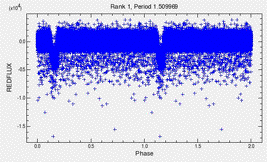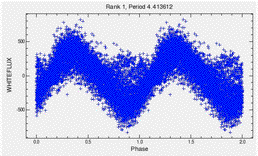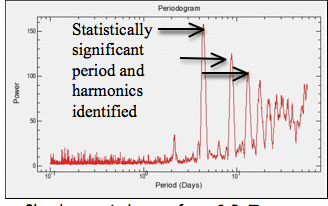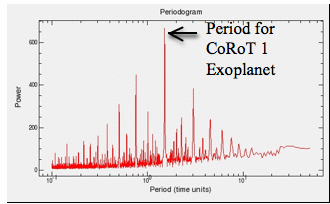Difference between revisions of "What is a periodogram?"
m (→NStED's tool) |
m |
||
| Line 41: | Line 41: | ||
The service intelligently selects the time and data value columns from the files for computing a periodogram with optimized default parameters. | The service intelligently selects the time and data value columns from the files for computing a periodogram with optimized default parameters. | ||
| − | |||
| − | |||
NStED’s service current supports the following periodogram algorithms: | NStED’s service current supports the following periodogram algorithms: | ||
| Line 50: | Line 48: | ||
Different periodogram algorithms are sensitive to different periodic signal shapes, and can be used in tandem as a powerful complementary analysis technique. | Different periodogram algorithms are sensitive to different periodic signal shapes, and can be used in tandem as a powerful complementary analysis technique. | ||
| + | |||
| + | The interface looks like this: [[image:period5.gif]] | ||
| + | |||
| + | You can adjust: | ||
| + | *File options | ||
| + | *Data columns to use in computation | ||
| + | *Simple data constraint filtering | ||
| + | *Period Sampling Options, including a variety of period-step methods | ||
| + | *Algorithm options custom to each algorithm, with optimized values chosen by default | ||
| + | *The number of phased curves to return | ||
| + | *Limits on the statistical significance of returned periods | ||
| + | *The statistics to use in computing the significance of periodogram power values | ||
| + | |||
| + | The brute-force nature of periodograms makes their computation become quickly time intensive on single-CPU systems as the number of observations and periods sampled grow. For example, the periodogram for a CoRoT light curve can take up to 30 minutes on a single CPU. | ||
| + | |||
| + | The brute-force nature of periodograms also make the algorithms readily available to parallelization. NStED has optimized our algorithms to be fully parallelized across a 128-core cluster. Computation times can be reduced to less than a minute for time-series data with hundreds of thousands of data values. | ||
Revision as of 06:53, 11 August 2010
This is from material originally developed by Peter Plavchan, NStED/IPAC.
What is a periodogram?
When you have a light curve, sometimes your eye can see repeated patterns in it. Sometimes your eye can be fooled, though -- things that seem periodic might not be, and it may seem like you have a noisy light curve, but it may turn out that you are sampling many repeated cycles of a periodic variation.
In order to look for periodic signals, there are several mathematical tools. A periodogram is one of them. There are lots of good textbooks on this subject; this wiki page is meant as just a quick introduction.
A periodogram calculates the significance of different frequencies in time-series data to identify any intrinsic periodic signals.
A periodogram is similar to the Fourier Transform, but is optimized for unevenly time-sampled data, and for different shapes in periodic signals. Unevenly sampled data is particularly common in astronomy, where your target might rise and set over several nights, or you have to stop observing with your spacecraft to download the data.
A periodogram is brute-force. Many different frequencies and candidate periodic signals are evaluated.
The statistical significance of each frequency is computed based upon a series of algebraic operations that depend on the particular algorithm used and periodic signal shape assumed.
Example: light curve for CoRoT-1: 
Why look for periods?
A variety of astrophysical phenomena can produce periodic time-series data, including:
- Stellar variability
- Eclipsing binaries
- Transiting planets
- Radial velocity planets
Time-series data of astrophysical objects are inherently noisy measurements -- photon noise, atmospheric conditions and other factors can introduce random variation into the magnitude of the observations.
Example: phased light curve for CoRoT source showing possible variation: 
and Plavchan periodogram for it: 
NStED's tool
NStED has designed an easy to use web interface for the community to use. You can upload your own data in IPAC ASCII format or as binary FITS tables.
NStED’s current holdings of space and ground-based light curves and radial velocities can be directly fed into our periodogram service from the time-series viewer.
The service intelligently selects the time and data value columns from the files for computing a periodogram with optimized default parameters.
NStED’s service current supports the following periodogram algorithms:
- Lomb-Scargle is an approximation of the Fourier Transform for unevenly spaced time sampling. It identifies periodic signals that are simple combinations of sines and cosines.
- Box-Least Squares (BLS) is optimized to detect periodic transits, by fitting the time series to a repeating "box"-shaped light curve.
- Plavchan is a binless phase-dispersion minimization algorithm that identifies periods with coherent phased light curves (i.e., least “dispersed”). There is no assumption about the underlying shape of the periodic signal.
Different periodogram algorithms are sensitive to different periodic signal shapes, and can be used in tandem as a powerful complementary analysis technique.
The interface looks like this: 
You can adjust:
- File options
- Data columns to use in computation
- Simple data constraint filtering
- Period Sampling Options, including a variety of period-step methods
- Algorithm options custom to each algorithm, with optimized values chosen by default
- The number of phased curves to return
- Limits on the statistical significance of returned periods
- The statistics to use in computing the significance of periodogram power values
The brute-force nature of periodograms makes their computation become quickly time intensive on single-CPU systems as the number of observations and periods sampled grow. For example, the periodogram for a CoRoT light curve can take up to 30 minutes on a single CPU.
The brute-force nature of periodograms also make the algorithms readily available to parallelization. NStED has optimized our algorithms to be fully parallelized across a 128-core cluster. Computation times can be reduced to less than a minute for time-series data with hundreds of thousands of data values.
